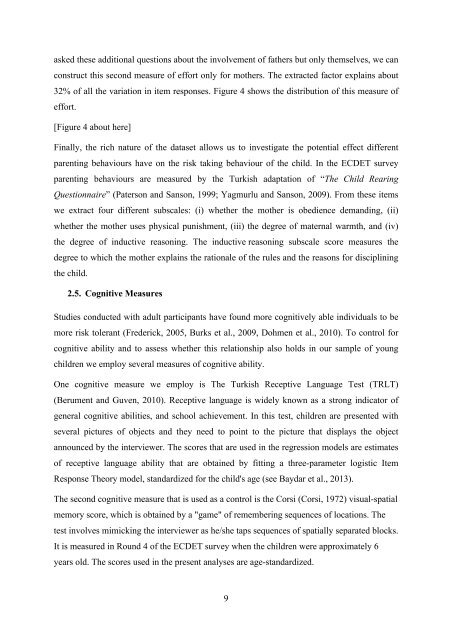Parental socialisation effort and the intergenerational transmission ...
Parental socialisation effort and the intergenerational transmission ...
Parental socialisation effort and the intergenerational transmission ...
- No tags were found...
Create successful ePaper yourself
Turn your PDF publications into a flip-book with our unique Google optimized e-Paper software.
asked <strong>the</strong>se additional questions about <strong>the</strong> involvement of fa<strong>the</strong>rs but only <strong>the</strong>mselves, we canconstruct this second measure of <strong>effort</strong> only for mo<strong>the</strong>rs. The extracted factor explains about32% of all <strong>the</strong> variation in item responses. Figure 4 shows <strong>the</strong> distribution of this measure of<strong>effort</strong>.[Figure 4 about here]Finally, <strong>the</strong> rich nature of <strong>the</strong> dataset allows us to investigate <strong>the</strong> potential effect differentparenting behaviours have on <strong>the</strong> risk taking behaviour of <strong>the</strong> child. In <strong>the</strong> ECDET surveyparenting behaviours are measured by <strong>the</strong> Turkish adaptation of “The Child RearingQuestionnaire” (Paterson <strong>and</strong> Sanson, 1999; Yagmurlu <strong>and</strong> Sanson, 2009). From <strong>the</strong>se itemswe extract four different subscales: (i) whe<strong>the</strong>r <strong>the</strong> mo<strong>the</strong>r is obedience dem<strong>and</strong>ing, (ii)whe<strong>the</strong>r <strong>the</strong> mo<strong>the</strong>r uses physical punishment, (iii) <strong>the</strong> degree of maternal warmth, <strong>and</strong> (iv)<strong>the</strong> degree of inductive reasoning. The inductive reasoning subscale score measures <strong>the</strong>degree to which <strong>the</strong> mo<strong>the</strong>r explains <strong>the</strong> rationale of <strong>the</strong> rules <strong>and</strong> <strong>the</strong> reasons for disciplining<strong>the</strong> child.2.5. Cognitive MeasuresStudies conducted with adult participants have found more cognitively able individuals to bemore risk tolerant (Frederick, 2005, Burks et al., 2009, Dohmen et al., 2010). To control forcognitive ability <strong>and</strong> to assess whe<strong>the</strong>r this relationship also holds in our sample of youngchildren we employ several measures of cognitive ability.One cognitive measure we employ is The Turkish Receptive Language Test (TRLT)(Berument <strong>and</strong> Guven, 2010). Receptive language is widely known as a strong indicator ofgeneral cognitive abilities, <strong>and</strong> school achievement. In this test, children are presented withseveral pictures of objects <strong>and</strong> <strong>the</strong>y need to point to <strong>the</strong> picture that displays <strong>the</strong> objectannounced by <strong>the</strong> interviewer. The scores that are used in <strong>the</strong> regression models are estimatesof receptive language ability that are obtained by fitting a three-parameter logistic ItemResponse Theory model, st<strong>and</strong>ardized for <strong>the</strong> child's age (see Baydar et al., 2013).The second cognitive measure that is used as a control is <strong>the</strong> Corsi (Corsi, 1972) visual-spatialmemory score, which is obtained by a "game" of remembering sequences of locations. Thetest involves mimicking <strong>the</strong> interviewer as he/she taps sequences of spatially separated blocks.It is measured in Round 4 of <strong>the</strong> ECDET survey when <strong>the</strong> children were approximately 6years old. The scores used in <strong>the</strong> present analyses are age-st<strong>and</strong>ardized.9
















